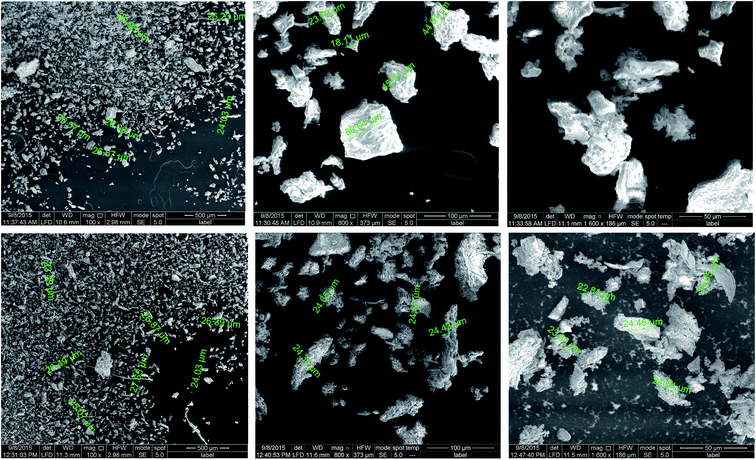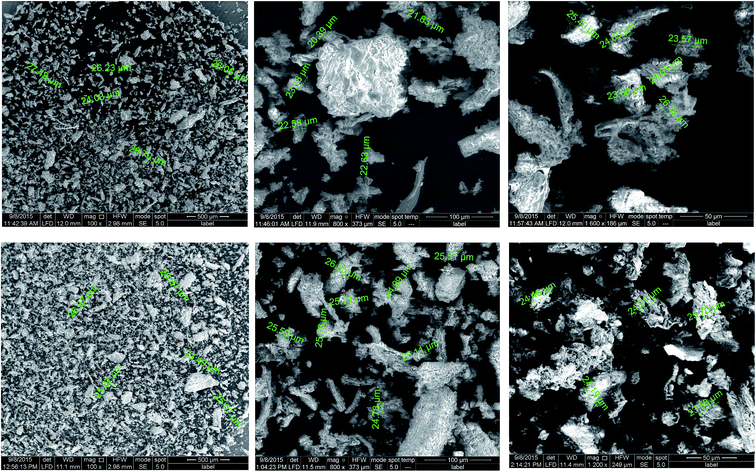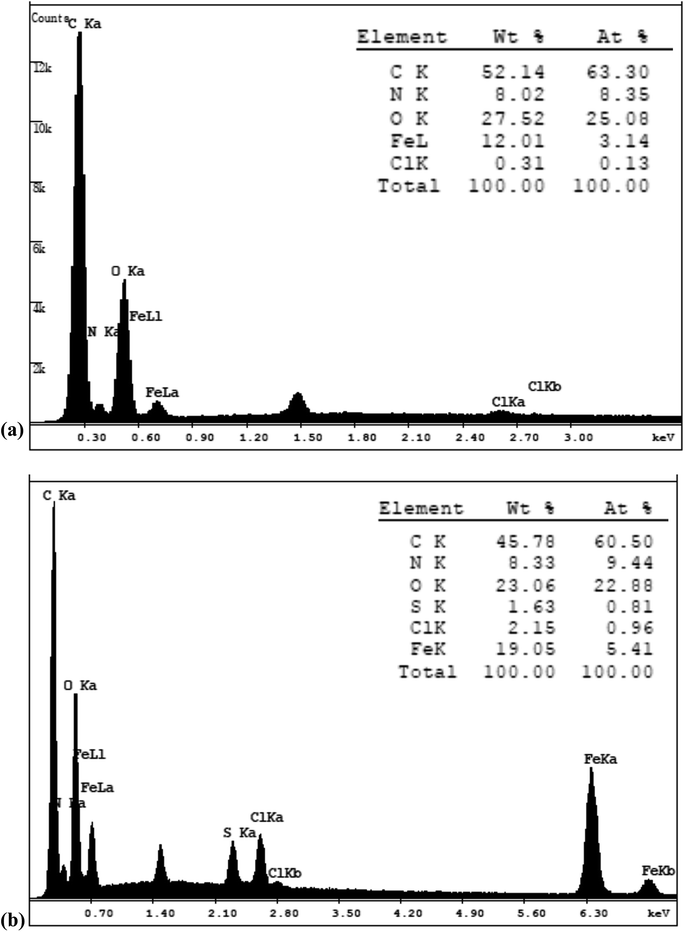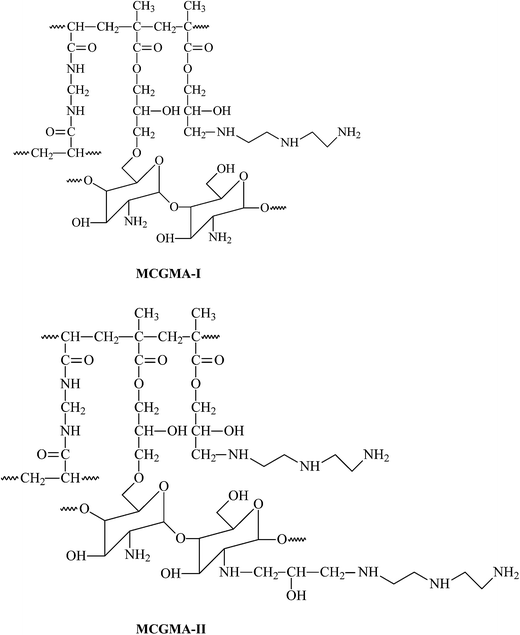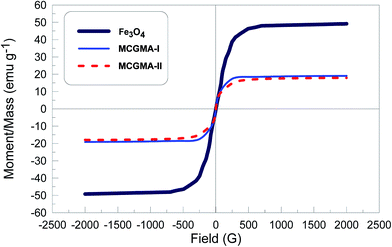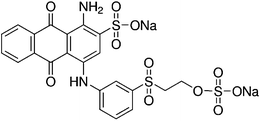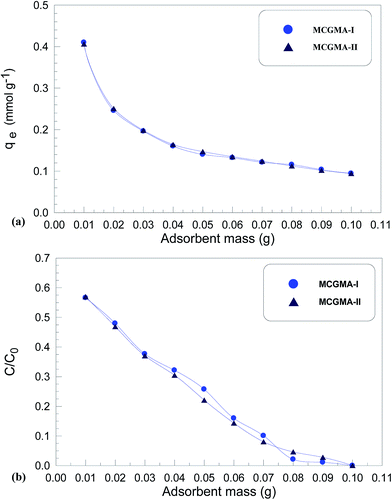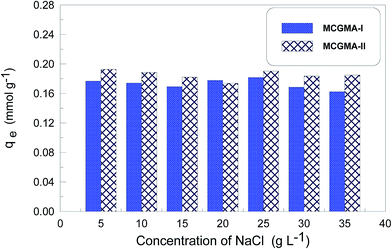Sorptive removal of Remazol Brilliant Blue R from aqueous solution by diethylenetriamine functionalized magnetic macro-reticular hybrid material†
K. Z. Elwakeel *a,
A. A. El-Bindaryb,
A. Ismaila and
A. M. Morshidyc
*a,
A. A. El-Bindaryb,
A. Ismaila and
A. M. Morshidyc
aEnvironmental Science Department, Faculty of Science, Port-Said University, Port-Said, Egypt. E-mail: Khalid_elwakeel@yahoo.com; Fax: +20 (0) 1061694332
bChemistry Department, Faculty of Science, Damietta University, Damietta 34517, Egypt
cNational Institute of Oceanography and Fisheries (NIOF), Baltim, Kafr Elsheikh, Egypt
First published on 12th February 2016
Abstract
Chitosan (natural polymer), glycidyl methacrylate (synthetic polymer) and magnetite are combined to produce novel magnetic macro-reticular hybrid synthetic–natural materials. The amino group concentration in the obtained materials was enriched through two different modification routes to generate effective sorbents for Remazol Brilliant Blue R (RBBR) ions. These materials showed a higher affinity towards the uptake of RBBR ions from aqueous media: maximum sorption capacity reached 0.153 mmol g−1 at pH 2.0 and at 25 °C. The nature of the interaction of RBBR with the sorbents was identified. The uptake kinetics and sorption isotherms were best described by the pseudo-second order rate equation and the Langmuir equation, respectively. The distribution coefficient was calculated at different temperatures and the thermodynamic parameters have been calculated: the sorption reaction is endothermic, spontaneous and increases the entropy of the system. Alkaline solution (0.5 M NaOH) was used for desorbing RBBR from loaded sorbents: a regeneration efficiency as high as 90–99% was obtained.
1. Introduction
The textile industry is a large sector and is considered the greatest creator of liquid dye effluents in the form of pollutants. Along with many industries such as textile, rubber, leather, paper, cosmetics, plastics, food, and pulp they use synthetic organic dyes and water to color their products.1 Textile effluents are ranked among the pollutants most harmful to the environment due to the high discharge volume and diversity in their composition, associated with the quantities of dye lost during the dying process.2 The water contaminated by dye at even a concentration of 1.0 mg L−1 would cause a change in color and make it improper for human usage.3 Remazol Brilliant Blue R (RBBR) is one of the most important identified contaminants among the various dye pollutants of industrial effluents. Due to its good solubility, reactivity, high toxicity and possible accumulation in the environment, RBBR is a common water pollutant and it may frequently be found in trace quantities in industrial wastewater.4,5 Large volumes of water are consumed by textile industries for wet processing of textiles.6 Discharging dyes into the aquatic resources can cause several problems as the presence of noisome synthetic dyes in the aquatic sources and food chain causes severe health risks on the living organisms, flora as well as fauna.7 The removal of noxious dyes from wastewater is currently based on a wide variety of physicochemical procedures, which include flocculation combined with flotation, membrane filtration, electro-kinetic coagulation, ozonation, oxidation, precipitation, photocatalytic degradation and sorption.8 However, most of the dyes used in the textile industry are difficult to remove by conventional physicochemical and biological treatment methods, since they are stable against the light and oxidizing agents and resist biodegradation.9 Sorption is the most widespread process that has been used in the field of industrial wastewater treatment.10 Recently, numerous studies proposed a variety of sorbent materials for the removal of dyes from wastewater.11–13 Among these a natural biopolymer, chitosan, which originates from shells of crustaceans obtained by the deacetylation of chitin has been recently investigated as a sorbent for the removal of both organic and inorganic contaminants.14–17 The hydrophilic nature, biocompatibility, biodegradability, antibacterial properties, nontoxicity, low-cost, fast sorption kinetics, and renewable nature have increased the application of chitosan in sorption processes.18 However its application on the industrial scale is limited by its insufficient mechanical strength and acid resistance.19 To overcome these disadvantages, chitosan-based composites have been prepared and proven to have resistance to acidic environments with better sorption.20 The selection, modification and elaboration of new composite sorbents for various pollutants reduction are important criteria in the development of wastewater treatment technologies. Nowadays composite polymeric materials play an essential role in the field of environmental technology.21,22 The increased interest of the scientific community in the polymeric macro-reticular materials composites is due to their properties as well as of the various requirements of the environmental field.23 Glycidyl methacrylate (GMA) is an attractive vinyl monomer because of its good mechanical strength, high tensile strength, resistance to acid and alkaline media, resistance to attrition, porous structure, low toxicity, and lower cost compared with other acrylic monomers.24 This polymer is a potent sorbent for various transition metals. Recently, we reported on the use of magnetic sorbents in the removal of some metals from aqueous solutions. These methods are cheap and often highly scalable. Moreover, techniques employing magnetism are more amenable to automation.25,26 Previously, we studied the sorption behavior of acidic dyes onto GMA, magnetic GMA and magnetic chitosan sorbents under different experimental conditions.27–29In a continuation of our research on magnetic chitosan, a magnetic macro reticular-material based on a synthetic polymer (GMA) and a natural polymer (chitosan) was developed for the efficient removal of RBBR dye from aqueous solution. This modification aims to enhance the mechanical strength and acid resistance of magnetic chitosan along with increasing the sorption capacity of magnetic chitosan by the further grafting of amino groups in magnetic chtiosan–GMA sorbent. The concentration of amino groups in the obtained materials was increased through the treatment with diethylenetriamine or epichlorohydrine followed by diethylenetriamine. The development of a sorbent and profitable operation of the sorption process requires the kinetic, equilibrium and thermodynamic data. Kinetic parameters such as the specific sorption rate constant, and sorption equilibrium play an important role in characterizing the sorption process. Isotherm results, kinetic and thermodynamic parameters for the sorption process of RBBR from aqueous solutions onto the prepared hybrid materials were obtained. These valuable data are dearly needed in the design and scale up to a pilot and commercial scale of any type of sorbent. The effect of several parameters, including the initial pH of the solution, the sorbent dose, and the effect ionic strength were studied. The regeneration of the loaded materials for repeated use was carried out.
2. Experimental
2.1. Chemicals
All chemicals used were of analytical-reagent grade and distilled water was used for the preparation of all aqueous solutions. Glycidyl methacrylate (GMA), N,N′ methylenebisacrylamide (MBA) and benzoyl peroxide (Bz2O2) were Fluka Analytical products. Chitosan, epichlorohydrine, diethylenetriamine (DETA) and Remazol Brilliant Blue R (RBBR) were Sigma-Aldrich products; Isopropyl alcohol was from Carlo Erba reagents. All other chemicals were Prolabo products and were used as received.Fe3O4 particles were synthesized by co-precipitation of ferric and ferrous salts according to a previously reported method.26
2.2. Preparation of the magnetic-macro-reticular hybrid material
Step 1: Magnetic chitosan particles were prepared by a co-precipitation method; 5 g chitosan powder was dissolved in 200 mL CH3COOH solution 8% (w/v). 6.479 g of FeCl3·6H2O and 3.334 g of FeSO4·7H2O were dissolved into 200 mL of distilled water, then 3.0 mL of 3.0 M HCl was added with continuous stirring for 20 min. After complete dissolution of the iron salts, it was poured on the dissolved chitosan. Then chemical precipitation was achieved at 40 °C under vigorous stirring by the drop wise addition of 20 mL of NaOH solution (50%, v/v). The product was isolated by filtration and washed with distilled water followed by ethanol then air dried. The product was ground to fine particles and is named MC.Step 2: The magnetic-chitosan–glycidyl methacrylate macro-reticular hybrid material was prepared through the polymerization of GMA in the presence of MC particles (prepared in step 1). GMA (5.0 g) corresponding to a mass ratio of 50% (w/w, referred to chitosan amount) was used for GMA grafting. 0.4 g of MBA was used as a cross-linking agent. 0.15 g Bz2O (initiator) was added to the mixture with stirring. Five milliliters isopropyl alcohol and 40 mL of cyclohexane were mixed and then added to the former solution. All the contents were poured into a flask containing 200 mL (0.5%) polyvinyl alcohol and heated in a water bath at 75–80 °C with continuous stirring for 4 h. The product was filtered off then washed repeatedly with distilled water and acetone, then dried in air. The product is named MCGMA. The suggested chemical structure of MCGMA is shown in Scheme 1.
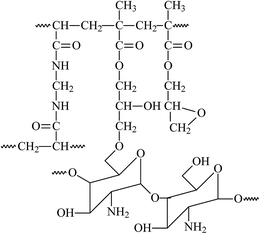 | ||
| Scheme 1 The suggested chemical structure of chitosan–glycidyl methacrylate–N,N′ methylenebisacrylamide (macro-reticular hybrid material). | ||
2.3. Chemical modification of MCGMA
![[thin space (1/6-em)]](https://www.rsc.org/images/entities/char_2009.gif) :
:![[thin space (1/6-em)]](https://www.rsc.org/images/entities/char_2009.gif) 1 v/v) was added. The above mixture was stirred for 24 h at 60 °C. The solid product was filtered off and washed several times with water. The obtained product was treated with DETA according to the method in Section 2.3.1. The product was dried in air and is referred to by MCGMA-II.
1 v/v) was added. The above mixture was stirred for 24 h at 60 °C. The solid product was filtered off and washed several times with water. The obtained product was treated with DETA according to the method in Section 2.3.1. The product was dried in air and is referred to by MCGMA-II.2.4. Estimation of the amine content
The amine content in the obtained resin was estimated using the volumetric method of HCl according the early reported method.23 Fifty milliliters of HCl (0.05 M) was added to 0.5 g of MCGMA-II or MCGMA-II and conditioned for 15 h on a shaker at 20 °C. The residual concentration of HCl was measured through the titration against 0.05 M standardized NaOH. The number of moles of HCl interacted with by the amino groups and consequently the amino group concentration was calculated using the following equation:
 | (1) |
2.5. Preparation of solutions
Distilled water was used for the preparation of all aqueous solutions. A stock solution (1.0 mM) of RBBR dye was prepared in distilled water. The desired concentrations were then obtained by dilution. HCl (0.01–0.05 M) and NaOH (0.01–0.05 M) were used to control the pH of the medium. 0.5 M of NaOH was used for elution of RBBR dye bonded to the sorbent.2.6. Characterization of the sorbents
In order to confirm the functionalization of the sorbents, MCGMA-I and MCGMA-II materials were examined in dried KBr powder by recording the infrared spectra over the range of 4000–400 cm−1 using a Fourier transform infrared (FTIR) spectrophotometer (FT/IR-4100typeA). The morphology and the elemental distribution of RBBR dye in the magnetic-macro reticular materials were analyzed using a Scanning Electron Microscope coupled with an Energy Dispersive X-ray analysis system (Quanta 250-FEI).The magnetic properties of the sorbents were measured on a vibrating-sample magnetometer (VSM) (Lake Shore 730T, Westerville OH, USA) at room temperature.
2.7. Sorption experiments
A stock solution (1 × 10−3 M) of RBBR dye was prepared in distilled water. The other solutions were obtained by dilution of the stock solution with distilled water just prior to the experiments. For the study of the pH effect 20 mL of 1 × 10−4 M of RBBR solutions at different pH values (in the range 1–9) were mixed with 50 mg of sorbent (dried weight) for 3 h, and the stirring speed was maintained at 40 rpm using a reciprocal agitator, Rota bit, J.P. Selecta (Spain). The pH values were adjusted by addition of 0.01–0.05 M HCl and 0.01–0.05 M NaOH solutions and measured by using a pH meter (Aqualytic AL15). Samples were collected and filtrated through magnetic separation and the filtrate was analyzed for residual RBBR dye concentration using a Perkin-Elmer AA800 spectrophotometer (Model AAS) at a wavelength of 595 nm. The pH was not controlled during the sorption but the final pH was systematically recorded.For sorption isotherms 50 mg of sorbent (m) was mixed with 20 mL (V) of RBBR dye solutions at different initial concentrations (C0, ranging between 1 × 10−4 and 1 × 10−3 M) for 3 h. The pH of the solutions was initially set at 3. After solid/liquid separation, the residual concentration (Ce, mmol RBBR L−1) was determined by a UV-vis spectrophotometer and the sorption capacity (qe, mmol g−1) was determined by the mass balance equation:
 | (2) |
For uptake kinetics 250 mg of sorbent was mixed with 100 mL of RBBR solution (C0: 5 × 10−4 M) at pH 3. Samples (5 mL) were collected (the sorbent being magnetically separated) at fixed times and the residual concentrations were determined using a UV-vis spectrophotometer. The agitation speed was set at 100 rpm while the temperature was maintained at 25 ± 1 °C. The sorbed amount of RBBR per unit weight of the sorbent at time t (q(t), mmol RBBR g−1), was calculated from the mass balance equation (taking into account the decrement in the volume of the solution) according to:
 | (3) |
The effect of temperature on the sorption of RBBR was tested out in 20 mL of dye solutions (5 × 10−4 M, pH 3) with 0.05 g of sorbent for 100 min at various temperatures.
The effect of sorbent dose on RBBR dye removal was tested out in 20 mL of dye solution (5 × 10−4 M, pH 3) at 25 ± 1 °C for 100 min.
Regeneration experiments were performed by contact of 0.3 g of the sorbent with 20 mL of 5 × 10−4 M RBBR at pH 3 for 100 min. The amount of dye sorbed (and the sorption capacity) was determined by the mass balance equation (eqn (1)). The solution was magnetically decanted and the sorbent was washed by distilled water. The loaded sorbent was mixed with 20 mL of 0.5 M NaOH for 30 min. The regenerated sorbent was magnetically decanted, then carefully washed by distilled water for reuse in the second run. The regeneration efficiency (RE, %) was calculated according to the following equation:
 | (4) |
3. Results and discussion
3.1. Sorbents characterization
FT-IR spectrometry was used to characterize the structure of the sorbents (Fig. SM1, see ESI†). The two sorbents have similar FT-IR profiles: the same bands appear on the two spectra, the only differences observed are small shifts in some of these bands. The large band in both sorbents around 3291–3299 cm−1 is generally attributed to the combination of stretching vibrations of OH and NH2 groups, while a series of –CH vibrations are reported around 2940–2942 cm−1. These bands are present in a wide number of compounds and they bring poor information on the specific properties of the sorbents. More interesting and representative are the different bands identified in the range 1800–400 cm−1. The bands at 1265–1267, 1161–1162 and 988–989 cm−1 are representative of the saccharide ring in both sorbents. The bands at 1652–1654 cm−1 is associated to the CONH2 group30 in MCGMA-I and MCGMA-II sorbents, while the bands at 1561–1562 cm−1 is probably assigned to the in-plane bending vibration of free amine groups and/or the asymmetric carboxylate stretching vibration in both sorbents.30,31 The grafting of diethylenetriamine, via glycidylmethacrylate, can be identified by the strong peaks observed around 1724–1722 cm−1 (assigned to C![[double bond, length as m-dash]](https://www.rsc.org/images/entities/char_e001.gif) O stretching vibration).32 Additional methylene (–CH2–) groups can probably be associated to the bands observed at 1469–1475 cm−1.33 The bands at 595–588 cm−1 in both sorbents were attributed to γ-Fe2O3.
O stretching vibration).32 Additional methylene (–CH2–) groups can probably be associated to the bands observed at 1469–1475 cm−1.33 The bands at 595–588 cm−1 in both sorbents were attributed to γ-Fe2O3.
The surface morphologies of MCGMA-I (before and after sorption) and MCGMA-II (before and after sorption) are shown in Fig. 1 and 2, respectively. The SEM micrographs reveal that the surface of both sorbents is porous, which can be clearly seen in the magnified view of the SEM micrographs, and the sorption of dye changed the surface structures of both MCGMA sorbents.
The Energy Dispersive X-ray analysis (EDX) of the MCGMA sorbents before and after sorption demonstrated that the surfaces of the sorbents contain various elements such as carbon, oxygen, nitrogen, and iron. It is observed that the sulfur is found on the sorbents’ surfaces after sorption process as shown in Fig. 3b and 4b, therefore it is revealed that the sorption of RBBR has ensued on the surface of MCGMA sorbents. The compositions of various elements in weight percentage (weight %) and atom percentage (atomic %) of the sample are illustrated in the graphical representation of EDX shown in Fig. 3 and 4. The level of the sulfur signal observed was sufficient for providing a qualitative idea of the homogeneous distribution of RBBR element at the surface of the sorbent: the percentage (in mass) of sulfur was 2.63% and 1.63% for MCGMA-I and MCGMA-II, respectively.
The amine content in MCGMA, MCGMA-I and MCGMA-II is 3.12, 5.42 and 5.86 mmol g−1, respectively. This confirms the enrichment of both MCGMA-I and MCGMA-II by amino groups. On the other hand, the amine content obtained by the HCl method for MCGMA-I and MCGMA-II is consistent with that obtained from EDX analysis (nitrogen mass percents are 7.93% (5.66 mmol g−1) and 8.02% (5.72 mmol g−1) for MCGMA-I and MCGMA-II, respectively). This indicates the success of the modification. The suggested chemical structures of MCGMA-I and MCGMA-II are shown in Scheme 2.
The magnetic properties of the materials were determined using VSM (vibrating sample magnetometry). Fig. 5 shows their typical magnetization loops. There was no remanence and coercivity, contrary to certain supported-magnetite materials.34 This means that MCGMA sorbents are paramagnetic. The saturation magnetizations of MCGMA-I and MCGMA-II were found to be about 19.1 and 17.9 emu g−1, respectively. These values are much smaller than the levels obtained for bulk phase magnetite (i.e., 49.21 emu g−1). The slight decrease in the magnetization in case of MCGMA-II may be due to the grafting of DETA via epichlorohydrin, which increases the mass of organic material and decreases the relative percentage of magnetite in the sorbent. The reported decrease in saturation magnetization can be explained by several factors including size effects and particle crystallization,35 and obviously by the fact that only a fraction of the sorbent (about 50%) is constituted by the magnetic core. A similar decrease in magnetization was observed for other chitosan–magnetite composites.36 Therefore, MCGMA sorbents can be readily separated with the help of an external magnetic field. This may be very helpful for solid/phase separation or for handling the material in hazardous environments.
3.2. Sorption of RBBR
| MCGMA-NH+Cl− + RBBR-SO3−Na+ ↔ MCGMA-NH+−O3S-RBBR + Cl− |
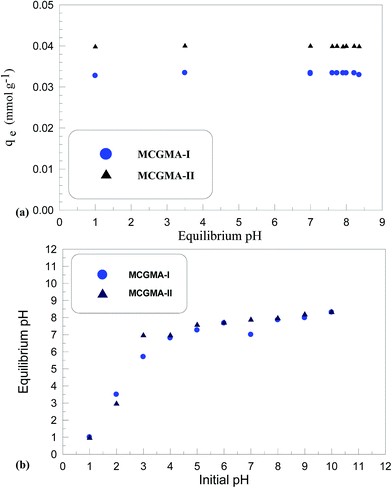 | ||
| Fig. 6 (a) Effect of pH on the adsorption of RBBR onto MCGMA-I and MCGMA-II; (b) the recorded initial and equilibrium (final) pH: (T: 25 ± 1 °C; C0: 5 × 10−4 M). | ||
MCGMA sorbents exhibited an almost similar sorption capacity at all pHeq levels (pH 1–8.36) in this study, and its sorption capacity decreased slightly from 0.033 to 0.32 mmol g−1 and from 0.04 to 0.039 mmol g−1 for MCGMA-I and MCGMA-II, respectively, with an increase in the pHeq from 1 to 8.36. The pKa (10.45) of diethylenetriamine is higher than that of chitosan (6.5), and the higher the pKa value of the ligand (DETA) grafted onto MCGMA sorbents, the wider is the effective pH range for anionic dye sorption.37
The effluent from textile industry is usually at an alkaline pH, and therefore MCGMA sorbents are suitable for the removal of RBBR from alkaline industrial effluent.
Fig. 6b shows the pH variation during RBBR sorption. At pH 1, the equilibrium pH is not significantly changed: the amount of protons exchanged due to protonation of the sorbent is negligible compared to the total amount of protons in the solution. In the range of initial pH 2–7, the equilibrium pH strongly increases up to 3.5–7.9 (depending on the sorbent): protons are bound to sorbent matrix. In the range of initial pH 8–10 the equilibrium pH decreases and the equilibrium pH tends to stabilize around 7.8–8.3: the pH values are close to the pKa value of amine groups of the ligand DETA,37 other types of inter-molecular forces, such as van der Waals force may be playing a role in RBBR sorption; this may explain the wide pH range for RBBR sorption on MCGMA sorbents.
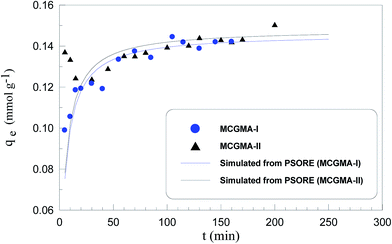 | ||
| Fig. 7 RBBR uptake kinetics using MCGMA-I and MCGMA-II sorbents (pH 3; T: 25 ± 1 °C; C0: 5 × 10−4 M). | ||
Actually, most sorption reactions take place through a series of mechanisms such as:38 (i) external film diffusion, (ii) intra-particle diffusion, and (iii) reaction between sorbate and active site (physisorption and/or chemisorption). The contribution of resistance to film diffusion to kinetic control can be easily reduced by providing a sufficient agitation; with an agitation speed of 100 rpm the effect of film diffusion can be neglected. This is confirmed by the steep initial sorption; film diffusion is usually considered the most significant during the first minutes of contact. The uptake kinetics has been modelled using four models: the so-called pseudo-first and pseudo-second order rate equations, the simplified model of resistance to intraparticle diffusion and the Elovich model.38 These models and their linear forms are reported in Table SM1 (see ESI†) where k1 is the pseudo first order rate constant (min−1) of sorption and qe and qt (mmol g−1) are the amounts of RBBR sorbed at equilibrium and time t, respectively, k2 is the pseudo second order rate constant (g mmol−1 min−1), Ki is the intraparticle diffusion rate (mmol g−1 min−0.5), α the initial sorption rate (mmol g−1 min−1) and β the desorption constant (g mmol−1). The validity of each model is checked by the correlation coefficient associated to linear fit. Accordingly, and as shown in Table 1, the analysis of their correlation coefficients shows that the PSORE gives a best fit of experimental data for RBBR sorption on both MCGMA-I and MCGMA-II sorbents. The solid lines in Fig. 7 show the modeling of kinetic profiles with the PSORE: the model fits well the kinetic data, though some discrepancies can be observed in the curvature zone. The poor fit of experimental data with the intraparticle diffusion model (Weber & Morris equation) confirms that the resistance to intraparticle diffusion is not the rate controlling step for uptake kinetics. As expected, designing magnetic macro-reticular hybrid particles contributes to significantly reduce the impact of resistance to intraparticle diffusion.
| Sorbent | qe (a) | PFORE | PSORE | Weber and Morris model | Elovich equation | |||||||||
|---|---|---|---|---|---|---|---|---|---|---|---|---|---|---|
| k1 (b) | qe,calc (a) | R2 | k2 (c) | qe,calc (a) | R2 | Ki (d) | X | R2 | α (e) | β (f) | R2 | |||
| a Units: (a) mmol g−1; (b) min−1; (c) g mmol−1 min−1; (d) mmol g−1 min0.5; (e) mmol g−1 min−1; (f) g mmol−1. | ||||||||||||||
| MCGMA-I | 0.142 | 0.034 | 0.056 | 0.815 | 1.455 | 0.146 | 0.998 | Ki1 | 0.0048 | 0.094 | 0.744 | 5.59 | 77.13 | 0.940 |
| Ki2 | 0.0028 | 0.111 | 0.677 | |||||||||||
| Ki3 | 0.0005 | 0.134 | 0.092 | |||||||||||
| MCGMA-II | 0.150 | 0.007 | 0.022 | 0.746 | 1.501 | 0.148 | 0.997 | Ki1 | 0.0027 | 0.111 | 0.770 | 121.36 | 100.45 | 0.915 |
| Ki2 | 0.0020 | 0.119 | 0.913 | |||||||||||
| Ki3 | 0.0011 | 0.129 | 0.506 | |||||||||||
Results of the intra-particle Weber–Morris diffusion model showed a multi-linear plot (Fig. SM4a, see ESI† Section), i.e. three linear sections of the plot qt versus t0.5, with fast kinetics in first step followed by gradual attainment of equilibrium for both sorbents. The multi-linear plot does not pass through the origin suggesting that intra-particle diffusion is not the sole rate-limiting step, but another step, e.g. film diffusion, could be process of highest resistance in a definite period of time. Significant differences of Ki values (Table 1) indicate the availability of the functional groups is primary controlled by diffusional transport through the pores system in the second and third steps; the structure of the porous sorbents, i.e. pores network, consists of macropores which extend into the particle interior and branch into a tree-like system of meso and micropores. The RBBR ions must diffuse through whole pore systems to reach the total surface area within the particles, where the intra-particle diffusion, resistance due to diffusional transport inside pores, slows down the overall process contributing to formation of a time-dependent concentration gradient due to fast kinetic process at surface, until saturation of all available surface sites was achieved. X represents the boundary layer diffusion effects (external film resistance). As the value of X decreases the effect of boundary layer diffusion on the reaction rate decreases. The obtained values of X (Table 1) indicate that the boundary layer diffusion effect (external film resistance) has a significant effect on the diffusion rate.
Elovich’s equation is another rate equation based on the sorption capacity. In 1934 the kinetic law of chemisorptions was established though the work of Zeldowitsch.39 It has commonly been called the Elovich equation; this Elovich equation was applied to the sorption of RBBR by the modified MCGMA sorbents. The values of α and β were determined from the intercept and slope, respectively, of the linear plot of qt vs. ln![[thin space (1/6-em)]](https://www.rsc.org/images/entities/char_2009.gif) t (Fig. SM4b, see ESI†). The values of α for the sorption of RBBR ions on the modified sorbents are 5.59 and 121.36 (mmol g−1 min−1) for MCGMA-I and MCGMA-II, respectively. These values indicate that the initial sorption rate of RBBR ions is relatively high compared with the previous studies of Elwakeel et al.;40,41 in that work, different modified chitosan sorbents were grafted with 3-amino-1,2,4 triazole,5-thiol or melamine to obtain efficient sorbents for dye recovery. The high initial sorption rate of RBBR on MCGMA sorbents may be attributed to the high concentration of active sites on the sorbent surface allowed for reacting with RBBR ions. The values of β are found to be 77.13 and 100.45 g mmol−1 for MCGMA-I and MCGMA-II, respectively; β is a factor associated with the degree of surface coverage and activation energy for chemisorptions. These results further support the assumption that the sorption is due to chemisorption.
t (Fig. SM4b, see ESI†). The values of α for the sorption of RBBR ions on the modified sorbents are 5.59 and 121.36 (mmol g−1 min−1) for MCGMA-I and MCGMA-II, respectively. These values indicate that the initial sorption rate of RBBR ions is relatively high compared with the previous studies of Elwakeel et al.;40,41 in that work, different modified chitosan sorbents were grafted with 3-amino-1,2,4 triazole,5-thiol or melamine to obtain efficient sorbents for dye recovery. The high initial sorption rate of RBBR on MCGMA sorbents may be attributed to the high concentration of active sites on the sorbent surface allowed for reacting with RBBR ions. The values of β are found to be 77.13 and 100.45 g mmol−1 for MCGMA-I and MCGMA-II, respectively; β is a factor associated with the degree of surface coverage and activation energy for chemisorptions. These results further support the assumption that the sorption is due to chemisorption.
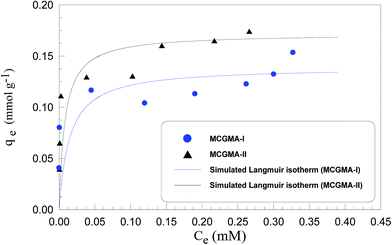 | ||
| Fig. 8 RBBR sorption isotherms onto MCGMA-I and MCGMA-II sorbents (solid lines are simulated from the Langmuir equation) (pH 3; T: 25 ± 1 °C). | ||
The equilibrium sorption isotherms are some of the most important data for determining the mechanism of RBBR sorption on the modified MCGMA sorbents. Several isotherm models have been used to describe experimental data for sorption isotherms. However, among these, three different appropriate isotherm models were selected for this work for the analysis of the equilibrium data: the Langmuir, Freundlich, and Dubinin–Radushkevich isotherm models.42 These models and their linear forms are reported in Table SM2 (see ESI†), where qe is the adsorbed value of RBBR at equilibrium concentration (mmol g−1), qL is the maximum sorption capacity or the saturation of the monolayer (mmol g−1) and KL is the Langmuir binding constant which is related to the energy of sorption (L mmol−1), Ce is the equilibrium concentration of RBBR in solution (mmol L−1). KF (mmol g−1) (L mmol−1)1/n and n are the Freundlich constants related to the sorption capacity and intensity, respectively. KDR (J2 mol−2) is a constant related to the sorption energy, QDR (mmol g−1) is the theoretical saturation capacity, ε (J2 mol−2) is the Polanyi potential, T is the temperature where the sorption occurs, AT (L mmol−1) is the Temkin isotherm constant, bT (J mol−1) is Temkin constant in relation to heat of sorption.
The Langmuir model is the simplest theoretical model for monolayer sorption onto a surface with a finite number of identical sites. It was originally developed to represent chemisorption on a set of distinct sorption sites. The values of qL and KL were determined from the slope and intercept, respectively, of the linear plot of Ce/qe vs. Ce (Fig. SM5a, see ESI†) of the Langmuir equation and are given in Table 2. The asymptotic shape of the sorption isotherm (Fig. 8) suggests that the Langmuir equation is probably more appropriate for fitting experimental data than the other equations (e.g., the exponential trend of the Freundlich equation is not consistent with the profile of the curve). The Langmuir model is based on the assumption that sorption sites are identical and energetically equivalent, and that sorption occurs at monolayer coverage. The Langmuir parameters can be used to predict the affinity between the sorbate and sorbent using the dimensionless separation factor RL
 | (5) |
| Sorbent | Langmuir model | Freundlich model | Dubinin–Radushkevich (D–R) model | Temkin model | ||||||||||
|---|---|---|---|---|---|---|---|---|---|---|---|---|---|---|
| qmax,exp (a) | qm,L (a) | KL (b) | R2 | n | KF (c) | R2 | QDR (a) | KDR (d) | Ea (e) | R2 | AT (f) | bT (e) | R2 | |
| a Units: (a) mmol g−1; (b) L mol−1; (c) mmol g−1 (L mmol−1)1/n; (d) J2 mol−2; (e) kJ mol−1; (f) L mol−1. | ||||||||||||||
| MCGMA-I | 0.153 | 0.139 | 68.424 | 0.965 | 0.153 | 8.053 | 0.861 | 0.1308 | 2.07 × 10−9 | 15.548 | 0.896 | 1089.21 | 240.500 | 0.850 |
| MCGMA-II | 0.174 | 0.171 | 124.45 | 0.988 | 0.224 | 5.509 | 0.851 | 0.173 | 3.39 × 10−9 | 12.150 | 0.900 | 53.240 | 140.818 | 0.915 |
The Freundlich isotherm model is applicable to highly heterogeneous surfaces. The values of n and KF were determined from the slope and intercept, respectively, of the linear plot of log![[thin space (1/6-em)]](https://www.rsc.org/images/entities/char_2009.gif) qe vs. log
qe vs. log![[thin space (1/6-em)]](https://www.rsc.org/images/entities/char_2009.gif) Ce (Fig. SM5b, see ESI†) of the Freundlich equation and are given in Table 2. A larger value of n implies strong interactions between the sorbent and dye anion. When n equals one it indicates linear sorption leading to identical sorption energies for all the active sites.
Ce (Fig. SM5b, see ESI†) of the Freundlich equation and are given in Table 2. A larger value of n implies strong interactions between the sorbent and dye anion. When n equals one it indicates linear sorption leading to identical sorption energies for all the active sites.
Another popular equation for the analysis of isotherms is that proposed by Dubinin and Radushkevich (Table SM2, see ESI†). This isotherm was developed to account for the effect of the porous structure of the sorbents, and the energy involved in the process. The Polanyi potential (ε) is given as eqn (6):43
 | (6) |
![[thin space (1/6-em)]](https://www.rsc.org/images/entities/char_2009.gif) qe vs. ε2 (Fig. SM6a, see ESI† Section) gives KDR and the intercept yields QDR (Table 2). The D–R constant (KDR) can give the valuable information regarding the mean energy of sorption by eqn (7):
qe vs. ε2 (Fig. SM6a, see ESI† Section) gives KDR and the intercept yields QDR (Table 2). The D–R constant (KDR) can give the valuable information regarding the mean energy of sorption by eqn (7):
 | (7) |
The Temkin equation was also used to model the sorption isotherm (Table SM2, see ESI†). The Temkin isotherm takes into account the interactions between sorbent particles and sorbate assuming that the free energy of sorption is a function of the surface coverage.44 The constant AT reflects the initial sorption heat of the sorbent: the greater the AT value the higher the sorption heat and the greater the affinity of the sorbent for the sorbate. The obtained values confirm the strong interaction between RBBR and the reactive groups at the surface of the MCGMA sorbents.
 | (8) |
The classic van ’t Hoff reaction isotherm equation describes the correlation between the free energy change (ΔG), standard free energy change (ΔGo) and equilibrium constant (Kc) at constant temperature (T) as:
ΔG = ΔGo + RT![[thin space (1/6-em)]](https://www.rsc.org/images/entities/char_2009.gif) ln ln![[thin space (1/6-em)]](https://www.rsc.org/images/entities/char_2009.gif) Kc Kc
| (9) |
At equilibrium, the free energy change (ΔG) is zero; hence the eqn (9) reduces to
ΔGo = −RT![[thin space (1/6-em)]](https://www.rsc.org/images/entities/char_2009.gif) ln ln![[thin space (1/6-em)]](https://www.rsc.org/images/entities/char_2009.gif) Kc Kc
| (10) |
This is the most important equation used in sorption thermodynamics to predict the feasibility of a sorption process. The standard free energy change is the free energy change of the sorption process at unit concentrations of sorbate and unit active sites of the sorbent.
To predict standard enthalpy change (ΔHo) and standard entropy change (ΔSo), eqn (10) can be rearranged in the form of equilibrium constant (Kc) as:
 | (11) |
According to classic thermodynamics, the thermodynamic parameters standard free energy change (ΔGo) is also related to standard enthalpy change (ΔHo) and standard entropy change (ΔSo) at constant temperature by the equation:
| ΔGo = ΔHo − TΔSo | (12) |
Therefore the van ’t Hoff equation becomes:
 | (13) |
The values of standard enthalpy change (ΔHo) and standard entropy change (ΔSo) for the sorption of RBBR are determined from the slope and intercept for the plot of ln![[thin space (1/6-em)]](https://www.rsc.org/images/entities/char_2009.gif) K versus 1/T and are listed in Table 3. The positive values of ΔHo confirm the endothermic nature of sorption process. The negative values of ΔGo (Table 3) indicate that the sorption reaction is spontaneous; the increase in the negativity of ΔGo with increasing temperature confirms that the sorption is favorable at higher temperatures. Also the values of ΔGo for MCGMA-II are more negative than that of MCGMA-I at low temperatures, which confirms that the sorption of RBBR ions is more favorable on MCGMA-II than MCGMA-I at low temperatures.
K versus 1/T and are listed in Table 3. The positive values of ΔHo confirm the endothermic nature of sorption process. The negative values of ΔGo (Table 3) indicate that the sorption reaction is spontaneous; the increase in the negativity of ΔGo with increasing temperature confirms that the sorption is favorable at higher temperatures. Also the values of ΔGo for MCGMA-II are more negative than that of MCGMA-I at low temperatures, which confirms that the sorption of RBBR ions is more favorable on MCGMA-II than MCGMA-I at low temperatures.
| Sorbent | ΔHo (kJ mol−1) | ΔSo (J mol−1 K−1) | T0 (K) | ΔGo (kJ mol−1) | ||
|---|---|---|---|---|---|---|
| 303 K | 308 K | 318 K | ||||
| MCGMA-I | 63.14 | 214.22 | 294.76 | −1.76 | −2.83 | −4.97 |
| MCGMA-II | 20.99 | 78.49 | 267.47 | −2.78 | −3.18 | −3.96 |
In industry the optimum temperature at which the sorption is highly feasible and spontaneous is essential. The range of temperature can be predicted from the value of temperature at which the standard free energy is zero (T0) for certain sorption processes. The zero standard free energy (T0) of certain sorption processes can be evaluated from eqn (14) with the same sign of thermodynamic parameters standard enthalpy change (ΔHo) and standard entropy change (ΔSo)
 | (14) |
This optimum temperature (T0) at which the standard free energy is zero predicts the actual range of temperature at which the sorption process is feasible and may be used in wastewater sorption treatment in chemical engineering technology. The calculated values of zero standard free energy temperature (T0) are 294.76 and 267.47 for MCGMA-I and MCGMA-II, respectively. The low T0 for MCGMA-II indicates the feasibility of RBBR removal at low temperature.
3.3. Comparison of sorption performance for RBBR ions with various sorbents
Table 4 shows a comparison of the maximum sorption capacities of materials found in the recent literature; the best operating conditions are also presented. A strict comparison is difficult since maximum sorption capacities were not obtained under similar experimental conditions; however, these data are sufficient to show that the modified MCGMA sorbents have a sorption capacity of the same order of magnitude as other sorbents (and in some cases better). The critical point that confirms the interest of these materials is the relatively fast sorption compared to other systems. The design of a magnetic core coated by a thin layer of chemically-modified MCGMA allows a reduction of the contribution of the resistance to intraparticle diffusion and makes kinetically very efficient sorbents for RBBR binding. The high sorption capacity of the modified MCGMA sorbents towards RBBR ions reveals that the sorbents could be promising for practical applications in RBBR ions removal from wastewater.| Adsorbent material | Initial pH | Contact time (min) | Temperature (°C) | Initial concentration (mg L−1) | Sorbent dosage (g L−1) | Sorption capacity (mg g−1) | References |
|---|---|---|---|---|---|---|---|
| Polyurethane-foam | 3.0 | 100 | 60 | 50 | 10 | 5.00 | 45 |
| Chitosan–lignin composites | 2.0 | 180 | 27 ± 2 | 300 | 2 | 95.93 | 46 |
| Sodium alginate/poly(N-vinyl-2-pyrrolidone) blend hydrogel | 1.2 | 600 | 25 | 250 | 1.3 | 55.28 | 47 |
| Coconut shell based activated carbon | 12.0 | 20 | 28.15 | 50 | 1.0 | 2.20 | 48 |
| Alumina/carbon nanotube hybrid adsorbents | 3.0 | 180 | 35 | 200 | 0.4 | 3.67 | 49 |
| P. eryngii immobilized on Amberlite XAD-4 | 2.0 | — | 38.7 | 36.3 | 6.08 | 1.92 | 50 |
| Functionalized multi-walled carbon nanotubes | 2.5 | 20 | 25 ± 2 | 100 | 0.5 | 177.52 | 51 |
| MCGMA-I | 2.0 | 60 | 25 ± 1 | 313 | 2.5 | 95.98 | This work |
| MCGMA-II | 2.0 | 60 | 25 ± 1 | 313 | 2.5 | 109.14 | This work |
3.4. Regeneration
Desorption of anionic dyes is generally operated by pH change. In most cases, desorption is performed under basic conditions. Regeneration of the MCGMA sorbents was carried out by contacting 20 mL of 0.5 M NaOH with the MCGMA sorbents for 30 min. Table 5 reports the evolution of regeneration efficiency for 4 sorption/desorption cycles. The sorbents show quite good stability in both sorption and desorption performance along the 4 sorption/desorption cycles. A slight decrease of sorption performance is observed but even at the fourth step the decrease in sorption efficiency is less than 5%. The hybrid magnetic macro-reticular materials can thus be used for repeated sorption/desorption cycles with high efficiency.| Cycle order | Sorbent | |
|---|---|---|
| MCGMA-I | MCGMA-II | |
| 1 | 99.9% | 99.8% |
| 2 | 99.4% | 100.2% |
| 3 | 95.9% | 99.9% |
| 4 | 98.6% | 98.4% |
4. Conclusion
Magnetic macro-reticular hybrid synthetic-natural materials were prepared based on glycidyl methacrylate (synthetic polymer) and chitosan (natural polymer). SEM and EDX analyses show irregular objects with very porous surfaces and the presence of sulfur after RBBR sorption. The prepared sorbents are characterized by efficient and selective sorption towards RBBR ions from aqueous medium at approximately pH 2. The uptake kinetics are most closely described by the PSORE, while the distribution of the metal at equilibrium between the solid and the liquid is modeled by the Langmuir equation. Sorption isotherms (fitted by the Langmuir equation) show maximum sorption capacities close to 0.153 and 0.174 mmol g−1 for MCGMA-I and MCGMA-II, respectively. The sorption mechanism is associated to an anion exchange/electrostatic attraction mechanism involving RBBR anions and charges of the sorbents. Increasing the concentration of NaCl hardly effects the sorption capacity. The nature of the sorption process is endothermic at the studied temperature range. The thermodynamic parameters show that the sorption is spontaneous and produces an increase in the “disorder” of the system. Finally, the RBBR anions can be efficiently desorbed from loaded sorbents with alkaline solution of 0.5 M NaOH and the sorbents can be reused for a minimum of 4 sorption/desorption cycles with a limited loss in efficiency (less than 5%) at the fourth sorption cycle.References
- C. Cao, L. Xiao, C. Chen, X. Shi, Q. Cao and L. Gao, In situ preparation of magnetic Fe3O4/chitosan nanoparticles via a novel reduction–precipitation method and their application in adsorption of reactive azo dye, Powder Technol., 2014, 260, 90–97 CrossRef CAS.
- M. M. El-Zawahry, F. Abdelghaffar, R. A. Abdelghaffar and A. G. Hassabo, Equilibrium and kinetic models on the adsorption of Reactive Black 5 from aqueous solution using Eichhornia crassipes/chitosan composite, Carbohydr. Polym., 2016, 136, 507–515 CrossRef CAS PubMed.
- R. Malik, D. S. Ramteke and S. R. Wate, Adsorption of malachite green on groundnut shell waste based powdered activated carbon, Waste Manage., 2007, 27, 1129–1138 CrossRef CAS PubMed.
- Y. Zhang, P. Su, J. Huang, Q. Wang and B. Zhao, A magnetic nanomaterial modified with poly-lysine for efficient removal of anionic dyes from water, Chem. Eng. J., 2015, 262, 313–318 CrossRef CAS.
- M. Shanehsaz, S. Seidi, Y. Ghorbani, S. M. R. Shoja and S. Rouhani, Polypyrrole-coated magnetic nanoparticles as an efficient adsorbent for RB19 synthetic textile dye: Removal and kinetic study, Spectrochim. Acta, Part A, 2015, 149, 481–486 CrossRef CAS PubMed.
- M. L. Parisi, E. Fatarella, D. Spinelli, R. Pogni and R. Basosi, Environmental impact assessment of an eco-efficient production for coloured textiles, J. Cleaner Prod., 2015, 108, 514–524 CrossRef CAS.
- A. C. S. Rocha, M. A. Reis-Henriques, V. Galhano, M. Ferreira and L. Guimarães, Toxicity of seven priority hazardous and noxious substances (HNSs) to marine organisms: Current status, knowledge gaps and recommendations for future research, Sci. Total Environ., 2016, 542, 728–749 CrossRef CAS PubMed.
- V. Gupta, Application of low-cost adsorbents for dye removal—a review, J. Environ. Manage., 2009, 90, 2313–2342 CrossRef CAS PubMed.
- V. K. Gupta, R. Kumar, A. Nayak, T. A. Saleh and M. A. Barakat, Adsorptive removal of dyes from aqueous solution onto carbon nanotubes: A review, Adv. Colloid Interface Sci., 2013, 193–194, 24–34 CrossRef CAS PubMed.
- M. T. Yagub, T. K. Sen, S. Afroze and H. M. Ang, Dye and its removal from aqueous solution by adsorption: A review, Adv. Colloid Interface Sci., 2014, 209, 172–184 CrossRef CAS PubMed.
- V. Singh and Preeti, Mesoporous titania spheres derived from sodium alginate-gum acacia composite beads: Efficient adsorbent for "Reactive blue H5G" dye, J. Environ. Chem. Eng., 2015, 3, 2727–2737 CrossRef CAS.
- G. B. Oguntimein, Biosorption of dye from textile wastewater effluent onto alkali treated dried sunflower seed hull and design of a batch adsorber, J. Environ. Chem. Eng., 2015, 3, 2647–2661 CrossRef CAS.
- S. R. Shirsath, A. P. Patil, B. A. Bhanvase and S. H. Sonawane, Ultrasonically prepared poly(acrylamide)-kaolin composite hydrogel for removal of crystal violet dye from wastewater, J. Environ. Chem. Eng., 2015, 3, 1152–1162 CrossRef CAS.
- M. Vakili, M. Rafatullah, B. Salamatinia, A. Z. Abdullah, M. H. Ibrahim, K. B. Tan, Z. Gholami and P. Amouzgar, Application of chitosan and its derivatives as adsorbents for dye removal from water and wastewater: A review, Carbohydr. Polym., 2014, 113, 115–130 CrossRef CAS PubMed.
- N. Yan and X. Chen, Don’t waste seafood waste, Nature, 2015, 524, 155–157 CrossRef CAS PubMed.
- X. Chen, Y. Gao, L. Wang, H. Chen and N. Yan, Effect of treatment methods on chitin structure and its transformation into nitrogen-containing chemicals, ChemPlusChem, 2015, 80, 1565–1572 CrossRef CAS.
- Y. Gao, X. Chen, J. Zhang and N. Yan, Chitin-Derived Mesoporous, Nitrogen-Containing Carbon for Heavy-Metal Removal and Styrene Epoxidation, ChemPlusChem, 2015, 80, 1556–1564 CrossRef CAS.
- Z. Zhao, N. Liu, L. Yang, J. Wang, S. Song, D. Nie, X. Yang, J. Hou and A. Wu, Cross-linked chitosan polymers as generic adsorbents for simultaneous adsorption of multiple mycotoxins, Food Control, 2015, 57, 362–369 CrossRef CAS.
- F. G. L. M. Borsagli, A. A. P. Mansur, P. Chagas, L. C. A. Oliveira and H. S. Mansur, O-carboxymethyl functionalization of chitosan: Complexation and adsorption of Cd (II) and Cr (VI) as heavy metal pollutant ions, React. Funct. Polym., 2015, 97, 37–47 CrossRef.
- K. Lewandowska, Characterization of chitosan composites with synthetic polymers and inorganic additives, Int. J. Biol. Macromol., 2015, 81, 159–164 CrossRef CAS PubMed.
- Z. Li, T. Li, L. An, P. Fu, C. Gao and Z. Zhang, Highly efficient chromium(VI) adsorption with nanofibrous filter paper prepared through electrospinning chitosan/polymethylmethacrylate composite, Carbohydr. Polym., 2016, 137, 119–126 CrossRef CAS PubMed.
- K. Z. Elwakeel and E. Guibal, Arsenic(V) sorption using chitosan/Cu(OH)2 and chitosan/CuO composite sorbents, Carbohydrate Polymers, Carbohydr. Polym., 2015, 134, 190–204 CrossRef CAS PubMed.
- K. Z. Elwakeel and E. Guibal, Selective removal of mercury(II) from aqueous solution by functionalized magnetic-macromolecular hybrid material, Chem. Eng. J., 2015, 281, 345–359 CrossRef CAS.
- T. S. Anirudhan, L. Divya and J. Parvathy, Arsenic adsorption from contaminated water on Fe(III)-coordinated amino-functionalized poly(glycidylmethacrylate)-grafted TiO2-densified cellulose, J. Chem. Technol. Biotechnol., 2013, 88, 878–886 CrossRef CAS.
- K. Z. ELwakeel and A. A. Atia, Uptake of U(VI) from aqueous media by magnetic Schiff’s base chitosan composite, J. Cleaner Prod., 2014, 70, 292–302 CrossRef CAS.
- K. Z. ELwakeel, A. A. Atia and E. Guibal, Removal of uranium from aqueous medium using tetraethylenepentamine modified magnetic chitosan resin, Bioresour. Technol., 2014, 160, 107–114 CrossRef CAS PubMed.
- K. Z. Elwakeel, Removal of Reactive Black 5 from Aqueous Solutions using Magnetic Chitosan Resins, J. Hazard. Mater., 2009, 167, 383–392 CrossRef CAS PubMed.
- K. Z. Elwakeel and M. M. Alrekaby, Efficient removal of reactive black 5 from aqueous media using glycidyl methacrylate resin modified with tetraethelenepentamine, J. Hazard. Mater., 2011, 188, 10–18 CrossRef CAS PubMed.
- K. Z. Elwakeel, A. A. El-Bindary, A. Z. El-Sonbati and A. R. Hawas, Adsorption of toxic acidic dye from aqueous solution onto diethylenetriamine functionalized magnetic glycidyl methacrylate -N,N’ methylenebisacrylamide, RSC Adv., 2016, 6, 3350–3361 RSC.
- L. F. Qi, Z. R. Xu, X. Jiang, C. H. Hu and X. F. Zou, Preparation and antibacterial activity of chitosan nanoparticles, Carbohydr. Res., 2004, 339, 2693–2700 CrossRef CAS PubMed.
- A. T. Paulino, A. G. B. Pereira, A. R. Fajardo, K. Erickson, M. J. Kipper, E. C. Muniz, L. A. Belfiore and E. B. Tambourgi, Natural polymer-based magnetic hydrogels: Potential vectors for remote-controlled drug release, Carbohydr. Polym., 2012, 90, 1216–1225 CrossRef CAS PubMed.
- S. H. Huang and D. H. Chen, Rapid removal of heavy metal cations and anions from aqueous solutions by an amino-functionalized magnetic nano-adsorbent, J. Hazard. Mater., 2009, 163, 174–179 CrossRef CAS PubMed.
- J. Coates, Interpretation of Infrared Spectra, A Practical Approach, Encyclopedia of Analytical Chemistry, ed. R. A. Meyers, John Wiley & Sons Ltd, Chichester, U.K., 2000, pp. 10815–10837 Search PubMed.
- X. Wang, Z. Zhao, J. Qu, Z. Wang and J. Qiu, Fabrication and characterization of magnetic Fe3O4-CNT composites, J. Phys. Chem. Solids, 2010, 71, 673–676 CrossRef CAS.
- B. Wang, Q. Wei and S. Qu, Synthesis and characterization of uniform and crystalline magnetite nanoparticles via oxidation-precipitation and modified co-precipitation methods, Int. J. Electrochem. Sci., 2013, 8, 3786–3793 CAS.
- D. H. K. Reddy and S.-M. Lee, Application of magnetic chitosan composites for the removal of toxic metal and dyes from aqueous solutions, Adv. Colloid Interface Sci., 2013, 201–202, 68–93 CrossRef CAS PubMed.
- S. Chatterjee, T. Chatterjee and S. H. Woo, Influence of the polyethyleneimine grafting on the adsorption capacity of chitosan beads for Reactive Black 5 from aqueous solutions, Chem. Eng. J., 2011, 166, 168–175 CrossRef CAS.
- S. S. Gupta and K. G. Bhattacharyya, Kinetics of adsorption of metal ions on inorganic materials: A review, Adv. Colloid Interface Sci., 2011, 162, 39–58 CrossRef PubMed.
- J. Zeldowitsch, The catalytic oxidation of carbon monoxide on manganese dioxide, Acta Physicochim. URSS, 1934, 1, 364–449 Search PubMed.
- K. Z. Elwakeel, M. A. Abd El-Ghaffar, S. M. El-kousy and H. G. El-shorbagy, Synthesis of new ammonium chitosan derivatives and their application for dye removal from aqueous media, Chem. Eng. J., 2012, 203, 458–468 CrossRef CAS.
- K. Z. Elwakeel, M. A. Abd El-Ghaffar, S. Elkosy and H. G. El-shorbagy, Enhanced remediation of Reactive Black 5 from aqueous media using new chitosan ion exchangers, J. Dispersion Sci. Technol., 2013, 34, 1008–1019 CrossRef CAS.
- K. Y. Foo and B. H. Hameed, Insights into the modeling of adsorption isotherm systems, Chem. Eng. J., 2010, 156, 2–10 CrossRef CAS.
- M. M. Dubinin, E. D. Zaverina and L. V. Radushkevich, Sorption and structure of active carbons.I. Adsorption of organic vapors, Zh. Fiz. Khim., 1947, 21, 1351–1362 CAS.
- V. P. Temkin, Kinetics of ammonia synthesis on promoted iron catalysts, Acta Physicochim. URSS, 1940, 12, 217–222 Search PubMed.
- M. H. Bilir, N. Sakalar, B. Acemioglu, E. Baran and M. H. Alma, Sorption of Remazol Brilliant Blue R onto polyurethane-type foam prepared from peanut shell, J. Appl. Polym. Sci., 2013, 127, 4340–4351 CrossRef CAS.
- V. Nair, A. Panigrahy and R. Vinu, Development of novel chitosan–lignin composites for adsorption of dyes and metal ions from wastewater, Chem. Eng. J., 2014, 254, 491–502 CrossRef CAS.
- M. Inal and N. Erduran, Removal of various anionic dyes using sodium alginate/poly(N-vinyl-2-pyrrolidone) blend hydrogel beads, Polym. Bull., 2015, 72, 1735–1752 CrossRef CAS.
- A. Umar Isah, G. Abdulraheem, S. Bala, S. Muhammad and M. Abdullahi, Kinetics, equilibrium and thermodynamics studies of C.I. Reactive Blue 19 dye adsorption on coconut shell based activated carbon, Int. Biodeterior. Biodegrad., 2015, 102, 265–273 CrossRef.
- M. Malakootiana, H. J. Mansooriana, A. Hosseini and N. Khanjani, Evaluating the efficacy of alumina/carbon nanotube hybrid adsorbents in removing Azo Reactive Red 198 and Blue 19 dyes from aqueous solutions, Process Saf. Environ. Prot., 2015, 96, 125–137 CrossRef.
- V. Yonten, M. Tanyol, N. Yildirim, N. C. Yildirim and M. Ince, Optimization of Remazol Brilliant Blue R dye removal by novel biosorbent P. eryngii immobilized on Amberlite XAD-4 using response surface methodology, Desalin. Water Treat., 2015 DOI:10.1080/19443994.2015.1070760.
- S. Karimifard and M. R. A. Moghaddam, Enhancing the adsorption performance of carbon nanotubes with a multistep functionalization method: Optimization of Reactive Blue 19 removal through response surface methodology, Process Saf. Environ. Prot., 2016, 99, 20–29 CrossRef CAS.
Footnote |
| † Electronic supplementary information (ESI) available. See DOI: 10.1039/c5ra26508h |
| This journal is © The Royal Society of Chemistry 2016 |

